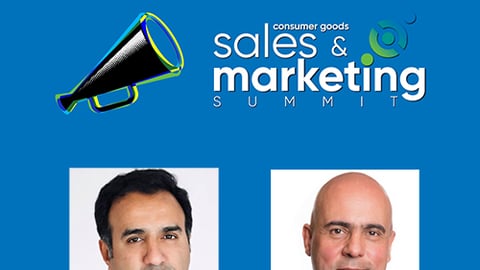Research Shows How CGs Are Prioritizing Data, Analytics in Sales & Marketing
CGT and Sigmoid recently conducted a webinar to dive into exciting insights such as the trends that are shape-shifting consumers who demand agility, digital transformation, and use of AI and ML in sales and marketing that define the consumer goods companies in the post-pandemic world.
Digging into the research showed that the pandemic gave a reality check to CGs on how they are utilizing digital capabilities; 31% of CG respondents cited “meeting new consumer demands/expectations” as one of the top three roadblocks to sales and marketing success. The other challenges are no clear view on what consumers want and how they will change. Companies are relying on data and analytics to understand constantly changing consumer patterns.
The panelists unanimously agreed that data is critical to understanding what consumers want. “However, it is important to have multiple data sources and diversified inputs to have a holistic picture,” said Meng Li, Former VP of Marketing, Native. She added that everything from large macro trends, social listening, and consumer feedback should be analyzed systematically to understand what customers want.
Ivonne Kinser, VP of Marketing and Innovation, Avocados From Mexico added that apart from qualitative and quantitative research, it is equally important to focus on dynamic data to have a real and accurate view of consumers. It can be collected through consumer data platforms that can be updated and optimized every day based on consumer interaction.
Post-Pandemic Trends Impacting Sales & Marketing
Only 16% of the US online adults believe that they will revert to a pre-pandemic sense of normalcy after COVID-19 cases subside. Some of the sales and marketing trends that are likely to stick are increasing e-commerce, growing customer acquisition costs, personalization, increasing use of AI, tailored consumer marketing, direct-to-consumer, and more.
“One of the areas where our marketing efforts are directed is direct-to-consumers. However, one of the major struggles of DTC is the sheer operational effort needed to build marketing operations,” shared Mary Rodgers, Director of Marketing Communications, Cuisinart.
Ivonne believes that the convergence of technologies in the last few years has been a significant trend. For instance, big data, which was popular in the last decade, is now enabled by AI and machine learning, giving new opportunities to understand customers and generate real-time insights. Another instance is the convergence of augmented reality with AI and ML to explore new avenues.
Personalization is another trend that panelists believe would be crucial for marketers to help decide whom to target and when and where. “For companies with a lot of customer data, personalization will become critical as companies try to get into optimization and improvement of campaigns. Companies are in fact, moving to hyper-personalization,” said Rahul Singh, Co-founder, and CAO, Sigmoid.
Li also highlighted the increased focus on content. There is a constant need to produce content at a pace and format that brands can consume. It requires a lot of investment and resources and is definitely on the upswing.
With changing consumer behavior such as an increasing shift towards online shopping, getting deep visibility is top of mind for CGs and retailers alike. However, they face roadblocks such as working in silos (48%), lack of retailer collaboration (45%), and lack of key or cleansed datasets (38%).
“Silos is a big issue and makes data integration hard to happen. But technology is breaking through it by bringing all kinds of data such as retailer and consumer in one place under a high privacy environment. We are investing in technology, researching, and being in the loop for any development of technology that can help us integrate data,” said Kinser.
Companies are also investing in developing a culture and talent development program to hire and retain talent. Li said that there is a high demand for talent in engineering and analytics. Most companies are not structured to synthesize all data points that the company has collected and are looking for ways to build a data team that can utilize data to its maximum potential. “You need different kinds of people with unique skillsets to turn data into something meaningful,” she said. Li also focused on the need to boost collaboration between internal resources and external agencies.
“Another challenge is the centralization of data and that most marketers are not prepared for privacy,” said Rodgers.
Investments in Tech
According to the CGT survey, companies are essentially talking about investment across product information management, personalization, e-commerce, digital marketing, social media analytics, and more in the next 2 years.
“Voice commerce is one of the things that is under our radar, and we are looking to integrate it into our business strategy,” shares Rodgers. On the other hand, Li vouches for cause marketing to be a significant area of investment in the coming years. For Kinser, the increasing investments in digital marketing and digital customer experience look promising.
Despite a major focus on personalization, only 4% of companies have embraced personalization. Rahul suggests that to up this number, CGs should have a strong data repository and loyalty program. “Companies need to define strategies, identify different levels of personalization, define customer-level interaction paths and datasets for these channels. Another important aspect is defining success criteria and testing the performance of the system that a company is building,” shared Rahul.
Use of AI/ML for Sales & Marketing
Almost 44% of CGs use AI/ML for social media marketing and analytics. Talking about its growing relevance, Rahul said that social media marketing collects so much data that you cannot process it without big data and AI technologies. On the other hand, in digital marketing, measurement is a primary area where AI is used. E-commerce and price management are other areas where AI is being used significantly.
Adding on to it, Li said that personalization and customer service are two areas where AI is picking up. While AI in personalization is used for recommendations and product displays to increase conversion ratio, customer service utilizes AI to resolve straightforward queries so that the team can focus on complex queries and customer relationships.
[See also: Consumer Goods Sales & Marketing Summit Virtual Experience, Dec. 13-15]
Kinser spoke about the use of AI in consumer data platforms to help identify the most valuable consumers and also help in targeting, segmenting, and optimizing the performance of campaigns.
Digital, DTC, and Social Commerce Acceleration
According to Gartner’s 2021 CMO Spend Survey, the amount of company revenue allocated to marketing across industries fell from an average of 11% in 2020 to 6.4% in 2021 — a cut of 4.6 percentage points and the lowest turnout in the history of the survey.
As marketing budgets are declining most companies are adopting plug-and-play models. With digital marketing spend increasing, marketing attribution is a challenge, and companies are struggling to optimize the marketing ROI. “There are a few providers of marketing attribution in the market, and they take time to create reports. Inflight optimization of campaigns is the hardest problem that companies face as it is time-consuming and costly. We have helped our clients overcome these challenges with our data solution,” said Rahul.
Closing Remarks
In a world where everything is shoppable, CGs are working to make the most of it by making every touchpoint, a conversion moment, and a sales channel. Brands are analyzing customer habits deeply by the right use of technology and having the right people in the team. As companies spend huge amounts of money for consumer journey mapping, marketers are looking to get an insight into their ROI, which requires technology integration.
“For integrating technology, you have to get everyone on board, led by a captain. It might look like a bumpy road, but it is the way forward,” said Rodgers on a concluding note.
ABOUT THE AUTHOR
Srishti Deoras is Content Marketing Manager at Sigmoid with a background in tech journalism. Her journalism background includes writing for, data science, data engineering, AI and biotechnology domains. In the last six years, she has extensively covered the data analytics landscape and is passionate about technologies that enable advanced analytics.










